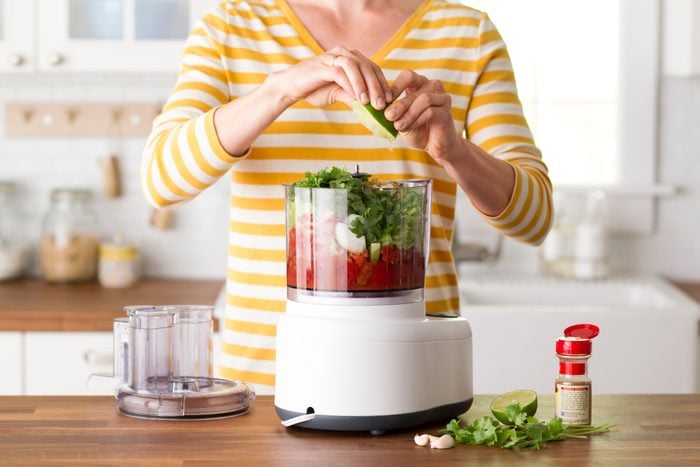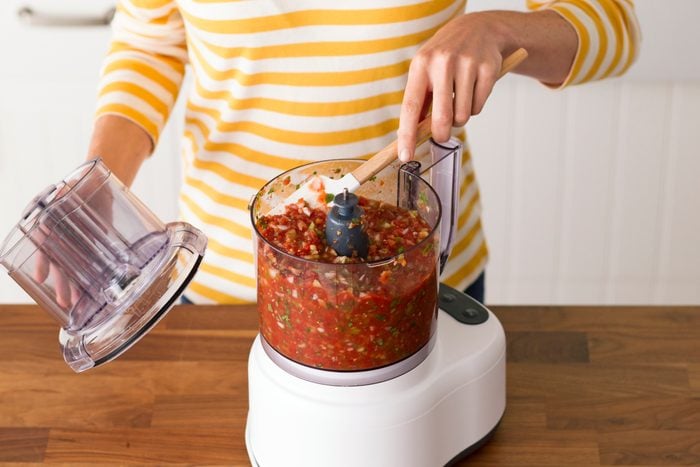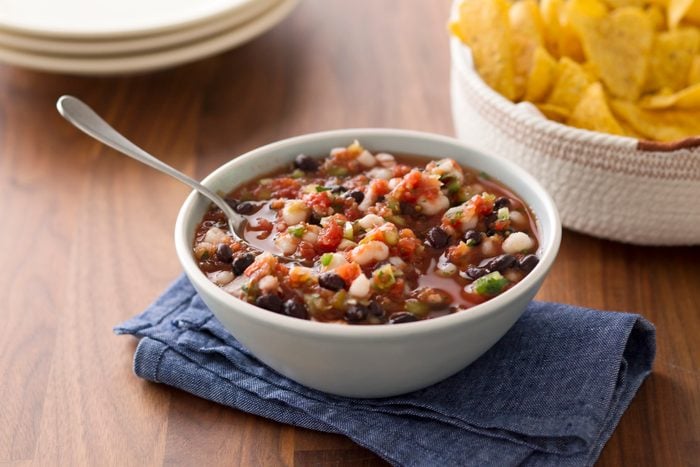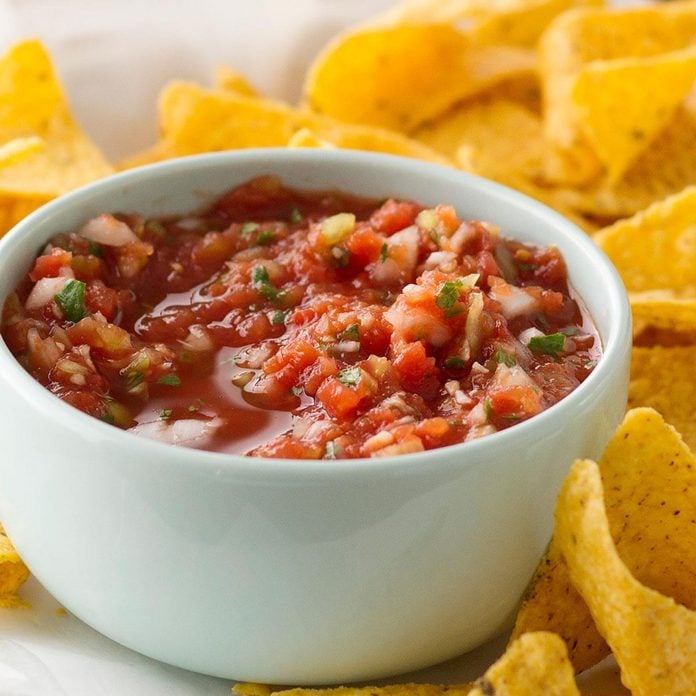If you have a food processor or a blender, there’s really no reason not to make salsa at home. It’s as easy as throwing ingredients together and pulse-pulse-pulsing until it’s done. This homemade, restaurant-style salsa is nothing like jarred salsa from the store. (Though we’ve found the best salsa brands!) It’s fresh, it’s full-flavored and you can really taste each individual component. You’ll find yourself diving in, dip after dip, whether you’re hungry or not.
Restaurant-Style Salsa Ingredients
- Canned whole tomatoes
- Canned diced tomatoes with garlic and onion
- Canned Mexican stewed tomatoes
- Canned diced tomatoes and green chilies
- Onion
- Banana peppers
- Jalapeno peppers
- Garlic cloves, minced
- Salt
- Cumin
- Fresh cilantro (optional)
- Lime juice
- Tortilla chips
Directions
Step 1: Prep ingredients

With canned tomatoes, this step is a breeze. Just drain the canned tomatoes (draining gives the salsa have a thicker texture) and toss ’em in the food processor. If you’re subbing fresh tomatoes, give them a rough chop and into the processor they go.
Next up is the peppers. Remove the seeds to make a milder salsa, or leave them in for the spicy, sinus-clearing kind. Always wear disposable gloves when cutting hot peppers (the oils can burn your skin).
Now all you have to do is mince the garlic, chop the cilantro and toss in the spices. Finish it off by squeezing in lime juice (some recipes call for vinegar, but we prefer the vibrant punch of fresh lime juice).
Test Kitchen Tip: We love fresh, summer tomatoes, but stick to the canned variety the rest of the year. Canned tomatoes are picked and packed at the peak of their freshness, which means you’ll have sweet, ripe tomatoes all year long.
Step 2: Pulse

Now that all the ingredients are in the food processor, it’s time to decide if you want chunky or smooth salsa.
Pulse the food processor a half dozen times and check the consistency. Scrape down the sides using a rubber spatula to make sure all the ingredients get incorporated. If you’re going for chunky salsa, stop here. For a smoother salsa, go ahead and pulse another half dozen times. When everything is well blended, those flavors really come together (plus it’s easier to keep the salsa on the chip).
Test Kitchen Tip: You can use a blender instead of a food processor, but it’s harder to make a chunky salsa. With the blender, you may have to stop and stir the ingredients from time to time—especially if your blender isn’t that powerful.
Step 3: Taste and serve

If you’re not tasting, you’re not cooking! Dip a chip and make sure the salsa is to your liking. Tasting with a chip allows you to fully experience the salsa, adding crunchy texture and salt to the party.
If you have time, give the salsa a few hours in the fridge (or overnight if you can) to marry and meld the flavors.
Test Kitchen Tip: If you think something’s missing but you can’t put your finger on it, add a small amount (one or two teaspoons) of neutral oil. Fat carries flavor, and the oil will add a decadent texture to the dip.
Restaurant-Style Salsa Variations
Once you’ve mastered the basics, you can add more flavor to your dip, as salsa is infinitely variable! Here are some of our favorite substitutions:
- Fruit: Swap out some (or all) of the tomatoes for fresh fruits like cherries, mango or pineapple. It’ll be bright, colorful, and add a nice sweet-tart flavor. Or blend in a few tablespoons of dried fruits (like tart cherries or raisins) or citrus zest (orange, lemon, or lime) to create a surprisingly nuanced flavor combo. If you love fruit salsa, learn how to make mango salsa at home.
- Black beans and corn: Make your salsa extra hearty by stirring in a can of black beans and a can of corn (drain and rinse them). If you’re feeling especially bold, substitute hominy for corn—this under appreciated ingredient is fantastically earthy and chewy.
- Tomatillos: Tomatillos bring a smoky astringency to your salsa and are totally worth the extra effort. You know, those gorgeous lantern-shaped orbs that you’ve been eyeing in the produce aisle? Sub in two pounds of bright green, firm tomatillos for the tomatoes. Prep them by peeling off the papery husks, rinsing, and broiling for 5 to 10 minutes, turning frequently, until they’re charred. (If you’re short on time, use jarred tomatillos and a teaspoon or two of adobo sauce to bring the smoky component.)
- Nuts: Have you ever had nuts in your salsa? This secret ingredient will make your dip simply unforgettable! Add a cup or two of roasted peanuts or cashews, blending them into a smooth salsa that’s both creamy and rich. It’s perfect for dipping or spooning over grilled chicken or veggies.
- Spices: Go crazy with the spices! You can easily customize salsa with your favorites from the spice rack. Go classic with cumin and oregano. Add warm spices like cinnamon, cloves or nutmeg to make fruit- or nut-based salsa sing. Just add those spices carefully—a little goes a long way!
Restaurant-Style Salsa Tips
How do you use leftover restaurant-style salsa?
- Marinades: Salsa is naturally acidic and bursting with salty flavor. Use it as a tenderizer or marinade for all types of meats.
- Soups: Looking to make your soup more exciting? Look no further than salsa. From black bean soup to chicken noodle, a few spoonfuls of salsa will be sure to amp up the flavors.
- Veggie bowls: Add salsa to a bowl filled with rice, beans and roasted vegetables.
- Breakfast: Scrambled eggs or bloody Marys get a hit of heat and bite with the addition of fresh (and potentially spicy) salsa.
- Burgers: Mix in a tablespoon or two into burgers for a fusion meal that can’t be beat. This trick works well for meatloaf or meatballs, too!
Can you freeze restaurant-style salsa?
If you find yourself with a bunch of extra salsa and can’t squeeze it into the weekly meal plan, head to the freezer. While fresh salsa tends to freeze poorly, cooked salsa freezes really well. If you’re using canned tomatoes or roasted tomatillos, freeze it up!




















